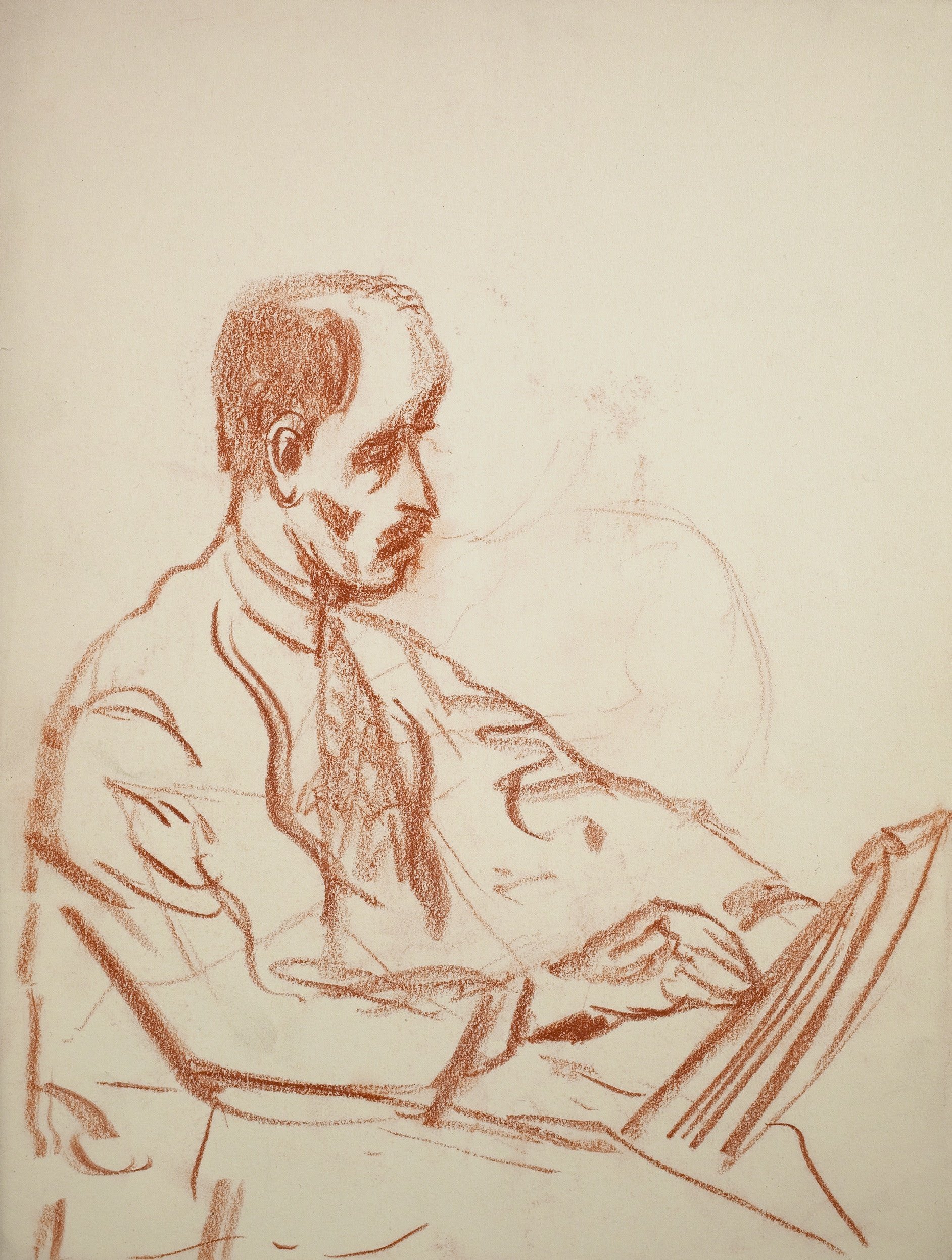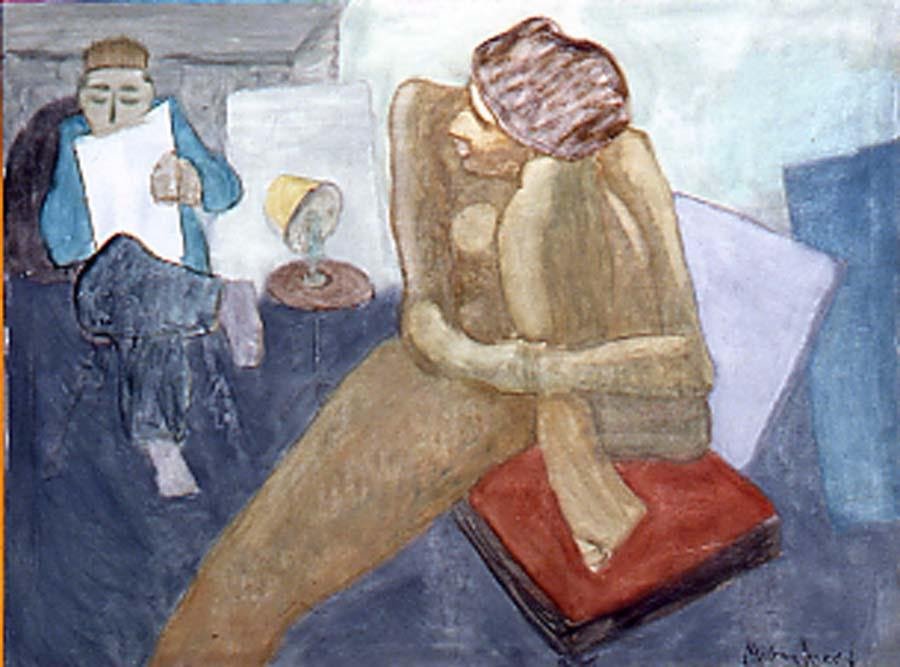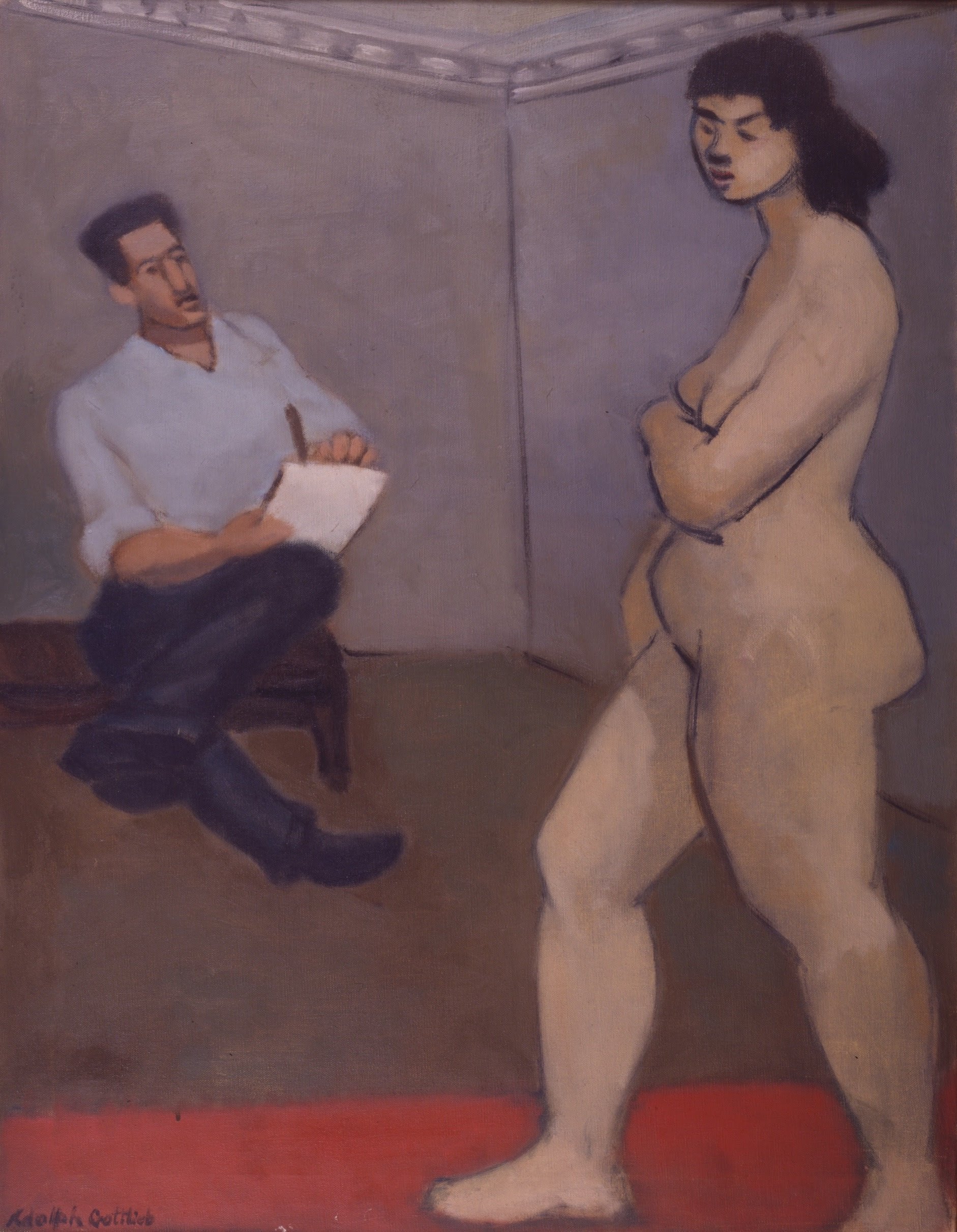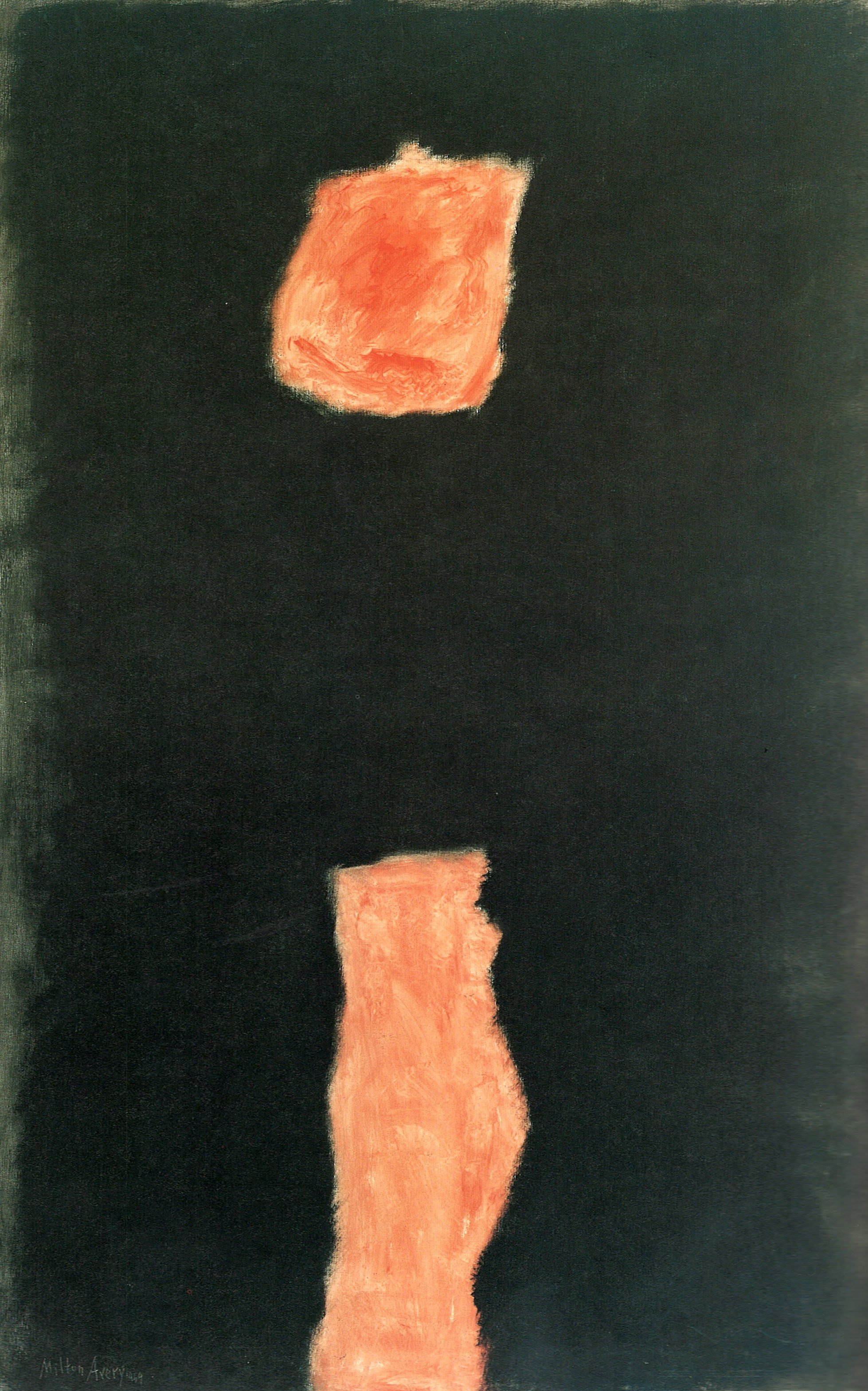"Avery's last works were as fresh as though he were a young painter and of course, they also had the authority of an old master. Avery is one of the few great painters of our time."
–Adolph Gottlieb
"At first Adolph painted moody landscapes; then he went on to bolder, simpler statements, his color becoming clearer and more melodious... for me, this has been exciting to watch."
–Milton Avery
Shown: Adolph Gottlieb (left) and Milton Avery (right) in Three Bridges, NJ, Summer 1936.
Adolph Gottlieb first met Milton Avery (1885–1965) in 1929 while showing at Opportunity Gallery on 56th Street in New York City, and the two became close and supportive friends. During the 1930s Adolph Gottlieb and Mark Rothko would frequent Milton and Sally Avery's Upper West Side studio. They would also spend occasional summers together in Three Bridges, NJ, Gloucester, MA, and southern Vermont. As Gottlieb stated, "...in the early '30s, I began to be influenced by Milton Avery. In 1932 I got married and we went up to Rockport for the summer. The Averys were there and we used to see an awful lot of them. He was a good 10 years older than I and at that point, the difference meant quite a bit...while he was painting a lot of portraits of his wife, I painted my wife. We'd paint scenes of Gloucester Harbor. I got into the habit of working the way he did but that was sort of natural for me because I had always worked from sketches. We'd go out and make sketches of Gloucester Harbor or people on the beach up in Gloucester and then go home and paint them."
Gottlieb and Avery's life-long friendship and mutual support for each other's work are documented below through interviews, correspondence, and artwork.
Shown: (left) Adolph Gottlieb, Untitled (Self Portrait in Mirror), c. 1938, oil on canvas, 39 7/8 x 29 5/8" (right) Milton Avery, Self Portrait, 1941, oil on canvas, 54 x 34", Neuberger Museum of Art, Purchase College, State University of New York, Milton Avery Trust.
“I have always thought he [Avery] was a great artist. When Social Realism and the American Scene were considered the important thing, he took an aesthetic stand opposed to regional subject matter. I shared his point of view; and since he was ten years my senior and an artist I respected, his attitude helped reinforce me in my chosen direction. I always regarded him as a brilliant colorist and draftsman, a solitary figure working against the stream.”
– Adolph Gottlieb quoted in The New York Post after Avery's death by Charlotte Willard, ''In the Art Galleries'', January 10, 1965
CORRESPONDENCE
Both Gottlieb and Avery celebrated each other's successes throughout their careers. Below you will find select correspondence and statements from both artists concerning several important life events. Their friendship lasted until Avery's death in 1965.
Shown: A letter from Milton Avery to Gottlieb in 1962 after Gottlieb suffered a heart attack, December 1962.
A letter from Milton Avery to Director Martin Friedman about Gottlieb's exhibition at The Walker Art Center, January 28, 1963.
A letter from Milton and Sally Avery to Adolph and Esther Gottlieb congratulating them on Gottlieb's exhibition at The Walker Art Center, May 24, 1963.
A letter from Adolph Gottlieb to Adelyn Breeskin of the Baltimore Museum of Art including a statement on Avery's work to include in a publication, September 25, 1959
Adolph Gottlieb's statement on Avery sent to Jack Fader of Gallery Reese Palley to include in the forward for the catalogue for their Milton Avery retrospective, May 29, 1968.
ARTISTIC INFLUENCE
Shown: (left) Milton Avery, Portrait of Adolph Gottlieb, pencil on paper, 11 x 18 1/2", Milton Avery Trust. (right) Adolph Gottlieb, Untitled (Sketch of Milton Avery), c. 1932, conte crayon on paper, 11 3/4 x 9"
"They [Adolph Gottlieb and Mark Rothko] were about ten years younger than Milton, but they all respected him a great deal and they used to hang around, as we'd say. You know, in the City, Rothko lived across the street from us and he'd be at our house almost every night. And Gottlieb would come in very often. And, you know, they'd bring their girlfriends and finally, they'd bring their wives when they had them and it was like a close-knit family. We were very close. And they used to bring their friends to show them what Milton was doing.
And I know how Baumbach says he remembers when Adolph Gottlieb took him up to show him Milton's work. And David Smith was in that group. It was nice and we were always together a lot. We were always having a lot of parties together and things like that."
–Sally Avery in an interview with Dorothy Seckler, November 3, 1967
Shown: (left) Milton Avery, Studious Sketcher, 1944-45, oil on canvas, 36 x 28", Cleveland Museum of Art, Milton Avery Trust. (right) Adolph Gottlieb, Untitled (Esther at Easel), c. 1937, oil on canvas, 40 x 36 1/8"
"Then we all went to Gloucester, I remember and everybody would work during the daytime and the evenings would be spent looking over the work people had done that day. They were all very anxious to see what Milton had done. Because Milton would do three or four watercolors a day and you know, with three or four watercolors every day you get a lot of ideas. But it was nice. And we'd play beach tennis and it was really, considering that - you know, we never drank, no one ever had a beer because we were very poor and at night time we'd sit around and have tea and crackers and just discuss painting. It was a really sort of dedicated time."
–Sally Avery in an interview with Dorothy Seckler, November 3, 1967
Shown: (left) Milton Avery, Artist and Model, c. 1939, oil on canvas, 38 x 50", Addison Gallery of American Art, Phillips Academy, Milton Avery Trust. (right) Adolph Gottlieb, Untitled (Artist and Model), 1934, oil on canvas, 31 3/4 x 24 7/8"
After returning from Arizona in 1939, “Gottlieb resumed his life in New York, but things had changed. He was no longer Avery’s young admirer, but an artist with ideas of his own. Although Avery disapproved, he continued to be interested in Surrealism - especially the art of Dali…he knew that Verist Surrealism contradicted the painterly tradition Avery stood for and to which he belonged, but he understood that to oppose Avery was the only way to find himself."
– Mary Davis MacNaughton in "Adolph Gottlieb: His Life and Art", 1981
"I have changed my mind about an idea of Milton's -- as he says, "don't try to paint a masterpiece." It seems to me now that that is the very thing to do -- try to make a masterpiece -- it probably won't be one anyway. Of course, from his point of view, Milton's right, there are many pictures that would be pretty good if they were not belabored and worked to death in trying for perfection. But right now I am sick of all the pretty good pictures and want a picture that is either damn good or no good."
– Adolph Gottlieb (in Tuscon, Arizona) in a letter to Harold Baumbach, January 18, 1938
"But then when we went to Arizona, I think Adolph had an opportunity to not be so much involved with Milton and Milton’s point of view. Not that Milton spoke very much but I mean just the aura of being with him and he was working so quickly... then from there, having drifted away from Avery, and Mark [Rothko] had also drifted away from the influence of Avery, I think they were also influenced by the fact that as a reaction to American scene painting, they were searching for some new subject matter."
– Esther Gottlieb in an interview with Phyllis Tuchman, 1981
Shown: (left) Milton Avery, Black Night, 1959, oil on canvas, 52 x 34", Milton Avery Trust. (right) Adolph Gottlieb, Under and Over, 1959, oil on canvas, 96 x 48"
"Though we do not see the Gottliebs as frequently now, we still maintain a warm relationship and deep friendship."
– Milton Avery in a letter to Martin Friedman, January 1963.
"My feeling is that Avery is sort of the American Matisse. He has a terrific flair for that sort of color."
– Adolph Gottlieb in an interview with Martin Friedman, August 1962
Milton Avery, Tangerine Moon and Wine Dark Sea, 1959, oil on canvas, 60 x 72", Milton Avery Trust.
Shown: Adolph Gottlieb, Hot Horizon, 1956, oil on canvas, 50 x 72", Yale University Art Gallery.


















